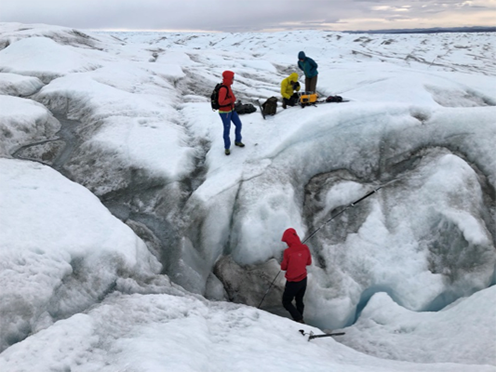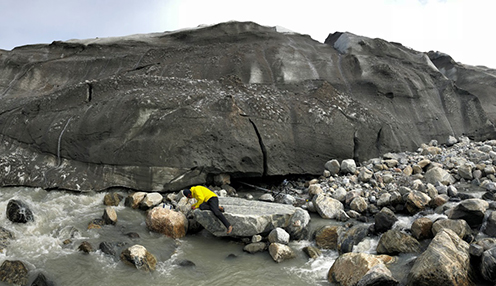New discovery: The Greenland Icesheet emits methane to the atmosphere
For the first time researchers has documented, that methane, a powerful greenhouse gas, is emitted directly to the atmosphere from under the ice and not only from wet permafrost soils. This new knowledge can change the way we measure how much methane is emitted from the land surface in the Arctic. The discovery has been done by researchers from University of Copenhagen and University of Aarhus.
”My colleague Christian Juncher Jørgensen from Aarhus Universitet and I could literally feel the cold wind from below the glacier in our faces, and with our measurement equipment we measured high concentrations of methane, significantly above the atmospheric level. This indicates, that methane is released from under the ice and directly to the atmosphere” tells Jesper Riis Christiansen from Department of Geoscience and Natural Resource Management, University of Copenhagen.

Researchers looking for methane in the air within crevices on the surface of the Greenland Ice Sheet.
Photo: Christian Juncher Jørgensen.
It was during field work near Kangerlussuaq, Western Greenland, that the two researchers discovered the phenomenon,that until now has been unknown to science, as a pathway for methane emission to the atmosphere. Their discovery has just been published in the journal, Scientific Reports, which is part of the Nature Publishing Group.
It is well-known that the permafrost in the Arctic is melting as the climate warms and that the thaw can result in significant release of methane to the atmosphere. Today, much research in the Arctic focuses on understanding the scope of methane release from thawing permafrost. The new data by Christian Juncher Jørgensen and Jesper Riis Christiansen shows, that methane is coming from under the ice.
”Whether this means, that the methane emission from the Arctic is far larger than previously assumed, is the big question. Only further investigations will make it possible to answer it. The size of the methane emission we have measured, justifies, that we continue our research in to this phenomenon” says Jesper Riis Christiansen.
Methane (CH4) as greenhouse gas is 20-25 times more powerful than carbon dioxide (CO2) and contributes with around 17% of the global warming.
Like opening a can of soda
”The next step is to achieve more clarity on what is causing the emission of the methane from under the ice. Because we have discovered the phenomenon at an active meltwater discharge point under the glacier, it is obvious to link the emission of methane to the amount of water flowing out from under the ice” states Jesper Riis Christiansen and continues:
”Deep below the Greenland Ice Sheet the methane is dissolved in the meltwater, as it is under immense pressure from the overlying ice. When the meltwater flows towards the edge this pressure is released and the dissolved gas can be released to the air. You can compare it to opening a can of soda!”

Jesper Riis Christiansen is taking water samples at the known source of methane from the ice. The measurement of this methane takes place in a natural cave under the ice (at the right of Jesper).
Photo: Christian Juncher Jørgensen
According to the researcher it is also important to find out where the methane originates from. Their investigation indicates, that the methane comes from microbes,that feed on organic carbon below the ice. This notion fits well with other studies of the life below ice sheet in Greenland and Antarctica.
To be able to conclude whether this newly discovered phenomenon is an important piece in the balance of the carbon balance of glacier, release of methane and the atmosphere’s composition of greenhouse gases, it is necessary to also discover if other glaciers in Greenland emits methane in the same way, as what Jesper Riis Christiansen and Christian Juncher Jørgensen have documented.
Read more
Read the paper in Scientific Reports
Read about the discovery on Videnskab.dk (in Danish)
Read on Planet Erde (German)
Related News
Contact
Jesper Riis Christiansen
Associate Professor
E-mail: jrc@ign.ku.dk
Tlf.: 35 33 69 42
Anette Bill-Jessen
Communications Coordinator
E-mail: anbj@ign.ku.dk
Tlf.: 93 51 13 70
